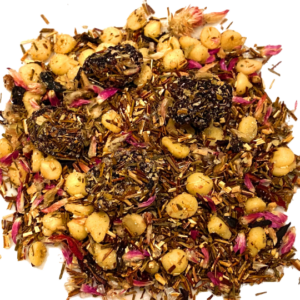Wrigley\’s Cottage Peony White Tea Blend is a minty, peony white tea tossed with cottage-garden blossoms. Our teas are handcrafted from the finest ingredients sourced from around the world. Each ingredient is carefully selected from growers that care about the environment and carefully blended in small batches in America. Like many of our artisan teas, the name has some connection to our loveable, furry friends at The Welsh Hills Inn. This one is our girl Wrigley\’s first \”solo\” tea. Our beautiful Golden Retriever, Ellie, has been hogging the limelight for too many years now!
Handcrafted in Ohio. Artisan tea ingredients are sourced worldwide. These include full leaves, fruits, berries, nuts, barks, roots, flower petals, and more. You can brew our teas hot or cold. Each container includes steep time, serving size, and ingredients.
INGREDIENTS: White Bai Mudan Tea, Peppermint, Lavender, Roses
NET WEIGHT: 2 oz. (53 g)


About Peony White Tea
White Peony, also called Bai Mudan, tea is a high-quality white tea fresh from a Chinese tea garden. White Peony is tea in its purest form. Containing 100% pure white tea buds, leaves, and twigs, this tea is only minimally processed by artisan farmers to preserve the natural fresh flavors.
As you’d expect from tea, this fresh, pure White Peony has a sweet aroma. Wrigley\’s Cottage Peony White Tea Blend rounds out the peony white tea with peppermint, lavender, and roses to deliver a refreshing cup of tea.
Because of minimal processing, white tea contains an abundance of the plant’s natural antioxidants. As a result, only a small amount of White Peony tea is available because only the most tender early-spring plants can be used.
Why is it white if it comes from the same plant as green and black tea? Because it is made from the unopened buds, which are clothed in a fuzz of fine, silvery “hairs,” giving it a whitish color. It has a pale yellow color and a delicate, slight sweetness when made into a tea. It lacks the grassy aftertaste of green tea.
White tea mainly grows in China in the mountains of Fujian Province. It is hand-picked in early spring and only within a tiny window utilizing only the most tender plants. This makes it more precious than the green and black varieties. It’s also processed differently. Processing is done in two steps, steaming and drying. Black tea gets its color from full fermentation. Similarly, only partially fermentation occurs with green tea. But white tea, such as Wrigley\’s Cottage Peony White Tea Blend, has no fermentation. White tea also does not require panning, rolling, and shaking.
Health Benefits | WellBeing Magazine Article
The minimal processing and the part of the plant harvested make white tea higher in antioxidant polyphenols than black and green tea. The antioxidants are more concentrated in the buds. These high amounts of antioxidants deliver many health benefits.
Improved Cardiovascular Function
Catechins reduce cholesterol, decrease blood pressure, and improve blood vessels\’ strength. As a result, this leads to a decreased risk of heart disease and stroke.
Antibacterial | Antiviral
White tea protects the body from bacteria, such as Salmonella, by boosting immunity. A study at Pace University found that white tea extract slowed viral, bacterial, and fungal growth. Additionally, it reduced infections such as Staphylococcus and Streptococcus. The same study found that adding it to toothpaste enhanced the antibacterial and antiviral effect of the toothpaste.
Anti-Inflammatory | Anti-Aging
A 2009 study at Kingston University in the UK found white tea has high anti-inflammatory, antioxidant, anti-collagenase, and anti-elastase properties. Because of this, it may protect against rheumatoid arthritis and other inflammatory conditions, some cancers, and heart disease. Similarly, it slows the breakdown of elastin and collagen due to aging and free-radical damage.
Anti-Cancer
Scientists from the Linus Pauling Institute at Oregon State University found that moderate white or green tea consumption may help prevent colon cancer. Similarly, at the Skin Study Centre at University Hospitals of Cleveland and Case Western Reserve University, researchers found that green and white tea helps skin cells to repair themselves after ultra-violet damage, which leads to skin cancer.
Bone-Density
Chinese, British, and Australian studies have found tea drinkers to have significantly better bone density and strength than non-tea drinkers. This makes it the ideal drink for anyone with osteoporosis and arthritis.





